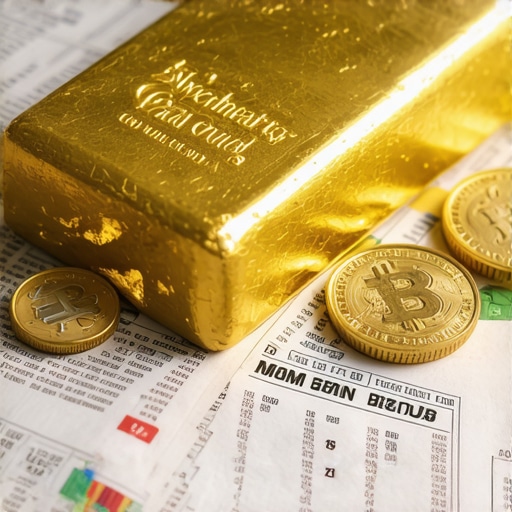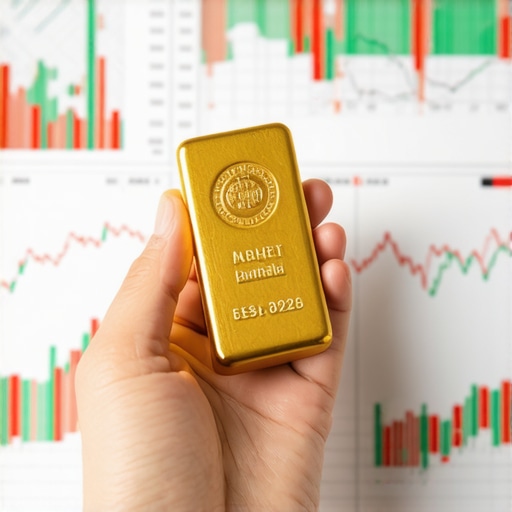Understanding the Nuances of Gold Investment Beyond the Basics
Investing in gold is often perceived as a straightforward hedge against economic uncertainty, yet the landscape is rife with complexities that beginners frequently overlook. Gold’s role as a tangible asset with intrinsic value makes it a unique investment vehicle, but novices must navigate pitfalls that can erode potential returns or increase risk exposure. This article draws on advanced market analysis and industry experience to highlight common mistakes beginners make when investing in gold, ensuring a foundation of informed decision-making.
Common Pitfalls That Undermine Gold Investment Strategies
Overvaluing Physical Gold Without Considering Liquidity and Storage Costs
Many beginners assume that purchasing physical gold bars or coins guarantees safety and liquidity. However, physical gold entails storage, insurance, and potential liquidity challenges, especially during volatile markets. The premium paid above spot price for physical gold can significantly impact net returns, making it critical to balance tangible ownership against associated costs. Exploring alternatives like gold ETFs or mutual funds offers diversified exposure with enhanced liquidity and lower transaction costs.
Underestimating Market Volatility and Timing Risks in Gold Trading
Gold prices are influenced by an array of macroeconomic factors including interest rates, currency fluctuations, geopolitical tensions, and central bank policies. Beginners often fall prey to emotional trading, mistiming entry and exit points which leads to suboptimal results. Understanding gold price trends and market drivers is essential to develop a disciplined investment approach and avoid reactive decisions fueled by short-term volatility.
What Are the Most Overlooked Risks for New Gold Investors?
Beyond the obvious price movements, beginners frequently neglect critical risks such as counterfeit products, unregulated dealers, and tax implications. The gold market’s fragmented nature demands due diligence when selecting dealers and storage solutions. For example, buying gold bullion safely requires knowledge of authentication methods and trusted sellers — resources like guides on avoiding scams and pitfalls are invaluable for novices. Additionally, understanding the tax treatment of physical gold and related investment vehicles can prevent unexpected liabilities.
Integrating Gold in a Balanced Portfolio: Strategic Considerations
While gold is often praised as a hedge against inflation and currency depreciation, improper allocation can diminish overall portfolio performance. Beginners should approach gold investment with a clear strategy aligned with their risk tolerance and investment horizon. Diversifying across physical gold, ETFs, mining stocks, and gold IRAs can optimize risk-adjusted returns. For instance, a Gold IRA offers tax advantages and long-term growth potential, complementing physical holdings and market-traded securities.
The Role of Global Supply and Demand Dynamics in Investment Success
Understanding the macroeconomic forces driving gold supply and demand is vital for anticipating price movements. Factors such as central bank purchases, geopolitical instability, and technological demand in electronics shape the market. Analytical insights from authoritative sources like the World Gold Council provide empirical data on these trends, guiding strategic timing and asset selection (World Gold Council – Gold Demand Trends).
Call to Action: Deepen Your Expertise in Gold Investment Strategies
For readers ready to elevate their gold investment acumen, exploring advanced techniques and diversified portfolio construction is crucial. Dive deeper into top gold investment strategies to protect wealth in 2025 and contribute your professional insights to the evolving discourse on precious metals investing.
Understanding Gold Market Liquidity: Beyond Physical Ownership
While physical gold offers tangible security, its liquidity can be limited compared to financial instruments. Investors must weigh the trade-offs between holding bullion and engaging with liquid assets like gold ETFs, which facilitate rapid transactions and portfolio flexibility. Moreover, market liquidity impacts bid-ask spreads and can significantly affect entry and exit prices during periods of market stress.
Assessing the Impact of Macroeconomic Policies on Gold Investment Strategies
Gold prices are intricately linked to central bank policies, inflation expectations, and currency valuations. For instance, quantitative easing and interest rate adjustments can either bolster gold’s appeal as an inflation hedge or reduce its attractiveness relative to yield-bearing assets. Investors should monitor policy signals closely, integrating this macroeconomic intelligence into tactical allocation decisions.
How Can Emerging Technologies Influence Gold Investment and Market Dynamics?
Emerging technologies such as blockchain and digital gold tokens are reshaping how investors access and trade gold. Tokenization enables fractional ownership, enhanced transparency, and potentially lowers barriers for retail investors. However, these innovations also introduce regulatory and custodial risks that require thorough due diligence. Understanding these developments can offer investors novel pathways to diversify within the precious metals space.
Risk Mitigation Through Diversification: Combining Physical Gold with Market Instruments
Strategic allocation between physical gold, mining stocks, ETFs, and derivatives can optimize risk-adjusted returns. Mining stocks, for example, offer leverage to gold price movements but carry operational risks. Conversely, gold futures provide opportunities for hedging and speculation but demand sophisticated market knowledge. Balancing these elements requires continuous market analysis and portfolio rebalancing.
The Role of Environmental, Social, and Governance (ESG) Factors in Gold Mining Investments
ESG considerations are gaining prominence among investors seeking sustainable and ethical exposure to gold mining companies. Mining operations with robust environmental stewardship, community engagement, and transparent governance tend to exhibit lower operational risks and enhanced long-term viability. Evaluating ESG metrics can refine stock selection within the gold sector, aligning investment goals with responsible practices.
For comprehensive insights on incorporating ESG into your gold portfolio, consider resources that analyze investment fundamentals alongside sustainability trends.
Expert Perspectives: Leveraging Data Analytics for Predictive Gold Market Insights
Modern investors increasingly rely on quantitative models and big data to anticipate gold price movements. Machine learning algorithms analyze historical patterns, geopolitical events, and economic indicators to generate probabilistic forecasts. While no model guarantees accuracy, integrating data-driven approaches can enhance decision-making frameworks and reduce behavioral biases.
According to a report by the World Gold Council, leveraging advanced analytics facilitates a deeper understanding of market dynamics, enabling investors to adapt swiftly to evolving conditions.
Enhancing Security and Trust: Best Practices for Gold Custody and Authentication
Ensuring the authenticity and secure storage of physical gold remains paramount. Investors should utilize reputable custodians, employ third-party verification services, and consider insured storage options. Digital certificates and blockchain-based provenance tracking are emerging tools that bolster transparency and reduce fraud risks.
To master these protective measures, explore detailed guidance on safe storage and authentication techniques.
Call to Action: Engage with the Gold Investment Community to Sharpen Your Strategy
We encourage readers to share their experiences and questions about gold investment strategies in the comments below. Engaging with a knowledgeable community can provide diverse perspectives and practical advice. For those seeking to expand their expertise, consider visiting gold trading techniques to navigate volatility for advanced tactics and market insights.
Harnessing Predictive Analytics: Machine Learning Applications in Gold Market Forecasting
Incorporating machine learning models into gold price forecasting has revolutionized investment strategies by enabling nuanced interpretation of multifaceted market signals. These algorithms process vast datasets encompassing historical price patterns, macroeconomic indicators, geopolitical developments, and even sentiment analysis from global news sources. Investors leveraging these tools can identify latent correlations and emerging trends that traditional analysis might overlook.
For example, supervised learning techniques like random forests and gradient boosting have shown efficacy in predicting short- to medium-term price movements by dynamically weighting variables such as interest rate changes, inflation data releases, and central bank gold reserves. However, practitioners must remain vigilant to pitfalls such as overfitting and data quality issues, maintaining a rigorous validation framework to ensure model robustness.
As highlighted in the World Gold Council’s Market Outlook Report, the integration of quantitative analytics empowers investors to navigate market volatility with greater confidence and precision.
Decoding ESG Metrics in Gold Mining: Beyond Compliance to Value Creation
Environmental, Social, and Governance (ESG) factors transcend regulatory compliance, emerging as critical determinants of long-term investment viability in gold mining enterprises. Advanced ESG assessment frameworks evaluate variables such as carbon footprint reduction initiatives, community relations, labor practices, and governance transparency, which collectively influence operational resilience and reputational capital.
Investors employing ESG scoring models can identify mining companies demonstrating proactive sustainability commitments, which often correlate with superior risk management and enhanced shareholder value. Furthermore, integrating ESG considerations aligns portfolios with evolving investor preferences and regulatory landscapes, fostering both ethical stewardship and financial performance.
Resources like the investment fundamentals guide provide comprehensive methodologies for embedding ESG criteria into gold mining stock selection.
What Are the Challenges in Applying Machine Learning to Gold Price Prediction?
While machine learning offers powerful predictive capabilities, its application in gold price forecasting is not without challenges. Data heterogeneity, including disparate sources and varying time frames, complicates model training. Moreover, the gold market’s susceptibility to black swan events—such as sudden geopolitical crises—introduces non-stationarity that can degrade model accuracy.
Interpretability also remains a concern; complex models may act as “black boxes,” limiting insight into driving factors behind predictions, which can hinder strategic decision-making. To mitigate these issues, hybrid approaches that combine domain expertise with algorithmic intelligence are advocated, ensuring that models are both robust and actionable.
Integrating Tokenization and Blockchain for Enhanced Gold Investment Transparency
Blockchain-enabled tokenization is ushering in a transformative era for gold investment by facilitating fractional ownership, immutable provenance records, and streamlined transactions. This technological evolution democratizes access to gold assets, lowering entry barriers and enhancing liquidity in traditionally illiquid physical gold markets.
However, investors must exercise due diligence regarding regulatory compliance, custodial arrangements, and platform security. Tokenized gold products often depend on third-party custodians for physical asset backing, necessitating transparent auditing and verification protocols to safeguard investor interests.
Engaging with these emerging digital gold instruments requires a sophisticated understanding of both technological and financial dimensions, representing a frontier for innovative portfolio diversification.
Unveiling the Frontier: Tokenization and Blockchain’s Disruptive Potential in Gold Trading
The advent of blockchain technology and tokenized gold assets is redefining traditional paradigms by enabling fractional ownership and enhancing transactional transparency. Tokenization dismantles historical barriers of entry, allowing investors to acquire precise portions of physical gold without the logistical burdens of storage or verification. This paradigm shift introduces liquidity to otherwise illiquid bullion holdings while simultaneously embedding immutable provenance records that mitigate fraud risks.
Nonetheless, these innovations necessitate a discerning approach due to regulatory ambiguities and reliance on custodial third parties for asset backing. Comprehensive due diligence and understanding of the underlying smart contract mechanisms remain imperative for safeguarding investments in this nascent space.

Leveraging Quantitative Analytics: Machine Learning in Gold Price Forecasting
Contemporary gold investors increasingly harness machine learning algorithms—such as random forests and gradient boosting—to decode complex, nonlinear interactions among macroeconomic variables, geopolitical events, and market sentiment. By integrating heterogeneous datasets, these models facilitate probabilistic forecasting that transcends traditional econometric limitations, thereby enabling refined tactical positioning.
However, challenges including overfitting, data quality inconsistencies, and the unpredictable nature of black swan events warrant rigorous validation protocols and hybrid approaches blending quantitative insights with expert judgment.
What Are the Practical Limitations and Challenges of Applying Machine Learning to Gold Market Predictions?
While machine learning enhances predictive power, practitioners confront issues such as model interpretability—where opaque “black box” outputs inhibit strategic clarity—and temporal non-stationarity arising from geopolitical shocks or macroeconomic regime shifts. Additionally, disparate data granularity and latency can degrade real-time applicability. To overcome these hurdles, a synthesis of domain expertise with algorithmic robustness fosters more resilient and actionable models.
Integrating ESG Factors: From Risk Mitigation to Value Creation in Gold Mining Investments
Environmental, Social, and Governance (ESG) frameworks have evolved beyond compliance checklists to become integral metrics of operational excellence and sustainable value generation within gold mining enterprises. Advanced ESG assessments scrutinize carbon emissions management, community relations, labor standards, and governance transparency—elements that collectively influence long-term profitability and reputational capital.
Investors prioritizing ESG-aligned companies often benefit from reduced regulatory risks, enhanced stakeholder trust, and superior risk-adjusted returns, aligning ethical imperatives with financial performance.
Engage with Cutting-Edge Gold Investment Insights
For those committed to mastering the evolving complexities of gold investment, deeper exploration of tokenization technologies, machine learning applications, and ESG integration is essential. Join the discourse by visiting our advanced gold investment strategies resource, and elevate your portfolio with forward-looking expertise.
Expert Insights & Advanced Considerations
Holistic Integration of ESG Factors Enhances Long-Term Gold Mining Investment Viability
Investors increasingly recognize that Environmental, Social, and Governance (ESG) metrics are not mere compliance checklists but pivotal determinants of sustainable value creation in gold mining enterprises. Companies demonstrating proactive carbon management, transparent governance, and strong community engagement often outperform peers by mitigating operational risks and enhancing reputational capital. Incorporating ESG analysis into gold mining stock selection aligns ethical stewardship with superior risk-adjusted returns, a critical approach for forward-thinking portfolios (investment fundamentals guide).
Machine Learning Models Enable Nuanced Gold Price Forecasting Amid Market Complexity
Advanced quantitative analytics, including random forests and gradient boosting algorithms, leverage multifaceted datasets encompassing macroeconomic indicators, geopolitical developments, and sentiment analysis to produce probabilistic forecasts of gold price movements. While these models enhance tactical decision-making, their efficacy depends on rigorous validation, awareness of overfitting, and integration with domain expertise to navigate black swan events and market non-stationarity effectively (gold market analysis).
Tokenization via Blockchain Unlocks Fractional Ownership, Democratizing Gold Investment Access
The emergence of blockchain-based tokenized gold assets offers innovative pathways for investors to gain fractional ownership with enhanced liquidity and transparent provenance. This technological evolution reduces traditional barriers related to storage and verification, yet demands meticulous due diligence regarding custodial arrangements, regulatory compliance, and smart contract security. Early adoption of tokenized gold instruments requires sophisticated understanding to fully harness their potential while managing unique risks (advanced gold investment strategies).
Strategic Diversification Across Physical Gold, ETFs, Mining Stocks, and Derivatives Optimizes Risk-Adjusted Returns
Combining various gold investment vehicles allows investors to balance liquidity, exposure, and risk. Physical gold provides tangible security but involves storage and liquidity considerations. ETFs and mutual funds offer diversified, liquid access to gold prices, while mining stocks provide leveraged exposure with operational risks. Derivatives like futures facilitate hedging and speculation but require advanced expertise. A disciplined allocation strategy aligned with individual risk tolerance enhances portfolio resilience (balanced gold portfolio).
Curated Expert Resources
- World Gold Council Research Hub – Offers comprehensive empirical data and market outlooks essential for understanding global gold supply-demand dynamics and forecasting price trends (Official site).
- BuyingGoldNow Advanced Strategies – Detailed insights into diversified gold investment techniques, tokenization, and ESG integration for sophisticated portfolio construction (Top Gold Investment Strategies).
- Gold Market Analysis 2025 – Expert breakdowns of macroeconomic factors influencing gold prices and volatility management strategies (Market Analysis).
- Investment Fundamentals Guide – Essential for integrating ESG principles and navigating secure gold purchases, especially for mining stocks and physical gold (ESG and Fundamentals).
- Gold Trading Techniques – Advanced tactics to navigate price volatility and optimize entry-exit strategies in dynamic markets (Trading Techniques).
Final Expert Perspective
Mastering gold investment in 2025 entails embracing a multifaceted strategy that synthesizes ESG integration, sophisticated quantitative analytics, technological innovation through tokenization, and strategic diversification. Each element contributes uniquely to navigating the complexities of modern gold markets, transforming gold from a simple hedge into a dynamic asset class capable of enhancing portfolio resilience and growth. By deepening expertise through authoritative research and engaging with evolving market mechanisms, investors position themselves to anticipate and capitalize on emerging trends. We invite seasoned investors and newcomers alike to further explore these advanced concepts and share professional insights to collectively elevate the discourse on gold investment. For a comprehensive roadmap to refining your gold strategy, visit our advanced gold investment strategies resource and engage with the community of experts shaping tomorrow’s precious metals landscape.










